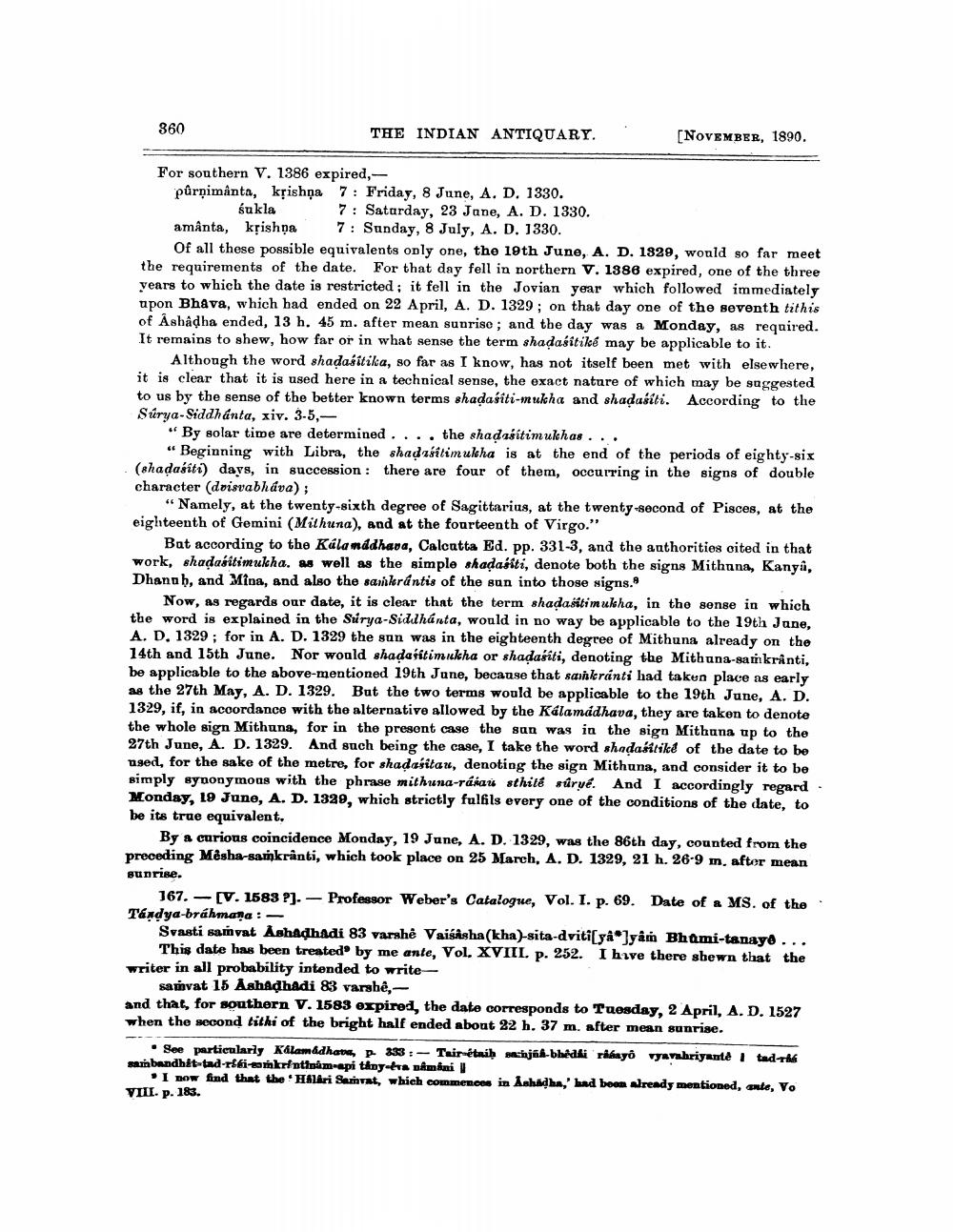________________
360
THE INDIAN ANTIQUARY.
[NOVEMBER, 1890.
For southern V. 1386 expired, pürņimanta, krishna 7: Friday, 8 June, A. D. 1330.
sukla 7: Saturday, 23 Jane, A. D. 1330. amânta, kțishọa 7: Sunday, 8 July, A. D. 1330.
Of all these possible equivalents only one, the 19th June, A. D. 1929, would so far meet the requirements of the date. For that day fell in northern v. 1986 expired, one of the three years to which the date is restricted; it fell in the Jovian year which followed immediately upon Bhava, which had ended on 22 April, A. D. 1329; on that day one of the seventh tithis of Ásbâdha ended, 13 h. 45 m. after mean sunrise ; and the day was a Monday, as required. It remains to shew, how far or in what sense the term shadasitiké may be applicable to it.
Although the word shadašitika, so far as I know, has not itself been met with elsewhere, it is clear that it is used here in a technical sense, the exact nature of which may be suggested to us by the sense of the better known terms shadasiti-mukha and shadabiti. According to the Súrya-Siddhanta, xiv. 3-5,
“By solar time are determined .... the shadırítimukhas ...
“Beginning with Libra, the shadıšitimukha is at the end of the periods of eighty-six (shadasita) days, in succession: there are four of them, occurring in the signs of double character (dvisvabháva);
"Namely, at the twenty-sixth degree of Sagittarius, at the twenty-second of Pisces, at the eighteenth of Gemini (Mithuna), and at the fourteenth of Virgo."
But according to the Kálanddhava, Calcutta Ed. pp. 331-3, and the authorities cited in that work, shadabitimukha, as well as the simple shadabiti, denote both the signs Mithuna, Kanyà, Dhann h, and Mina, and also the sankrantis of the sun into those signs.
Now, as regards our date, it is clear that the term shadašitimukha, in the sense in which the word is explained in the Súrya-Sidunánta, would in no way be applicable to the 19th June, A. D. 1329 : for in A. D. 1329 the sun was in the eighteenth degree of Mithuna already on the 14th and 15th June. Nor would shadasítim ukha or shadariti, denoting the Mithuna-sankranti, be applicable to the above-mentioned 19th June, because that sankranti had taken place as early as the 27th May, A. D. 1329. But the two terms would be applicable to the 19th June, A. D. 1329, if, in acoordance with the alternative allowed by the Kalamadhava, they are taken to denote the whole sign Mithuna, for in the presont case the sun was in the sign Mithuna tp to the 27th June, A. D. 1329. And such being the case, I take the word shadasitikê of the date to be used, for the sake of the metre, for shadasitar, denoting the sign Mithuna, and consider it to be simply synonymous with the phrase mithuna-rásau sthité súrye. And I accordingly regard. Monday, 19 June, A. D. 1329, which strictly fulfils every one of the conditions of the date, to be its trae equivalent.
By a curious coincidence Monday, 19 June, A. D. 1329, was the 86th day, counted from the preceding Mêsha-sankranti, which took place on 25 March, A. D. 1329, 21 h. 26-9 m, aftor mean sunrise.
167.-IV. 1583 ?). - Professor Weber's Catalogue, Vol. I. p. 69. Date of a MS. of the Tándya-bráhmana:
Svasti samvat AshAdhadi 83 varahe Vaissha (kha)-sita-dviti ya®]yam Bhami-tanayo...
This date has been treated by me ante, Vol. XVIII. p. 252. I have there shewn that the writer in all probability intended to write
samvat 15 Ashadhadi 83 varshê,and that, for southern V. 1583 expired, the date corresponds to Tuesday, 2 April, A. D. 1527 when the second tithi of the bright half ended about 22 h. 37 m. after mean sunrise.
See particularly Kalamadhan, p. 333 :- Tair étnih sanja-bheki ribayo vyavahriyante i tad the maibandhit-and-rfi samkrintinam api tiny hranimini
. I now find that the . H ari Samvat, which commences in Lahadha,'had been already mentioned, ande, Vo VIII. p. 183.




